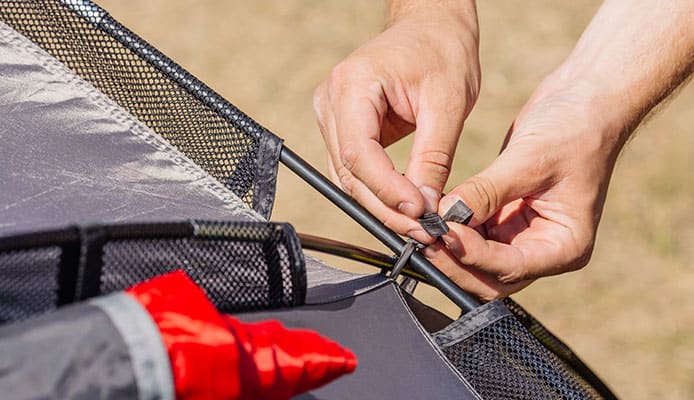What are the best tent poles? Which tent poles are right for me? Aluminium, fibreglass, steel, inflatable air poles, carbon fibre, … no poles. Poles are an important part of any tent – they hold up your tent. But do all poles do the job you want them to? Different pole types are suited to different types of tents, purposes and budgets.
FIBREGLASS TENT POLES
One of the most common pole materials as they do a pretty good job and are one of the cheapest options for poles. They are fairly flexible but can split, crack or break under stress, however, finding replacement poles or changing out a cracked section is not too difficult. Heavier and bulkier than some other options and so most suitable for lower-end small tents, and in larger family dome tents and car camping tents.
ALUMINIUM TENT POLES
Aluminium poles have a great strength to weight ratio, are durable, and not easily broken. They’re most often used in mid to high end lightweight camping tents but are more expensive so not often used in larger family dome tents. You can also find various grades of aluminium with some branded poles being really expensive. They are reliable but can corrode over time or may have problems where pole ends insert into pole hubs, but easily replaced or to switch out any problem sections.
CARBON FIBRE TENT POLES
Carbon poles are very strong and slightly lighter than aluminium but are very expensive so mostly found in high end lightweight tents. Quality may vary depending on fibers and resin used and proper manufacturing. Feedback on the reliability of carbon fibre poles varies greatly with reports of breakages if the pole is compromised in any way – seems weak points can fail under stress.
STEEL TENT POLES
Steel tent poles are very strong and reliable and won’t snap or bend. Used in a lot of canvas tents or bigger family tents, and to hold up tarps. On the downside they are very heavy and bulky and over time may corrode. Inflatable Air Poles The biggest benefit of inflatable air poles is that pitching the tent is easy … find the valve, inflate and watch it rise. New design developments mean the tubes used are tough and reliable, usually wrapped in 2 sleeves with leaks or damage being very rare. But they’re expensive, heavy and bulky and so most suitable for larger family tents or shelters.
NO POLES OR POLE ALTERNATIVES
More and more ultralight tents have the option of using one or two trekking poles to hold them up, reducing weight you need to carry. Other minimalist campers use what nature provides … trees, branches etc. and bikepackers using their bikes to hold up their tents or tarps. Lightens the load but may not suit everyone. Some tent poles might work better for you depending on what kind of camping you’re into and you’re your priorities are. Next up we’ll look at more info on tentpole specs, parts and terms.
Post time: Apr-19-2022











